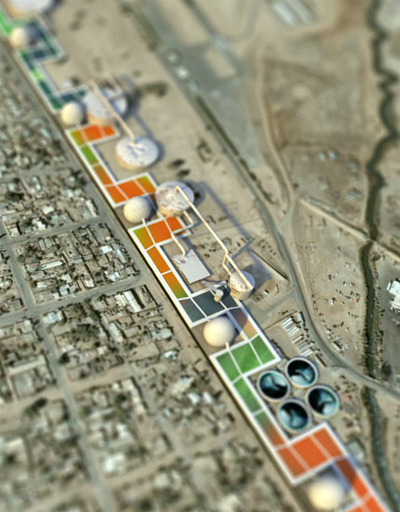
Aug '08 - Jun '10
While I was out inspecting bunkers and imagining how they might be integrated into some kind of territorial infrastructure for the Atlantic coast/North Sea this past fall, two teams working under Berkeley professors were busy putting together their phase II proposals for the WPA 2.0 competition sponsored by UCLA's cityLAB. Ron Rael/Virginia San Fratello and Nicholas de Monchaux (Ron and Nicholas are my advisors for thesis) along with their teams composed largely of Berkeley students, were selected along with four other teams out of 300 entries nationwide. They just got back from Washington D.C. a few weeks ago, and though neither team ended up coming out on top, I think it's great that some ideas and conceptual practices from Berkeley got national attention. Here's just a few quick snippets from the projects:
Rael San Fratello Architects: Border Wall as Infrastructure
Bi-National Library in Nogales, Arizona by Rael San Fratello Architects
From the project website:
By some measures, the U.S. Secure Fence Act of 2006 funded the single largest and most expensive building project in the United States of the 21st Century. It finances 700 miles of fortification dividing the U.S. from Mexico at the average cost of $4 million dollars per mile. ... This project suggests that the wall, at such prices, should and could be thought of not only as security, but also as productive infrastructure–as the very backbone of a borderland economy. Indeed, coupling the wall with viable infrastructure—and this proposal focuses on water, renewable energy, and urban social infrastructure—is a pathway to security and safety in border communities and the nation beyond them.
Read more here. A 20 million gallons/day wastewater treatment facility on the border between Mexicali, Mexico and Calexico, California by Rael San Fratello Architects
A 20 million gallons/day wastewater treatment facility on the border between Mexicali, Mexico and Calexico, California by Rael San Fratello Architects
Rael San Fratello's project is a good precedent for what I'm looking at, military bases also being US borders. Some questions linger for me. What does it mean to infuse these military-security infrastructures with the services of an architect? The task is how to be more projective in imagining what they could be, and not to get bogged down with so much criticality - or worse - to let that sort of project become a satire on a politically-loaded frontier.
Nicholas de Monchaux: Local Code:Real Estates
WPA2 : Local Code / Real Estates from Nicholas de Monchaux on Vimeo.



No Comments
Block this user
Are you sure you want to block this user and hide all related comments throughout the site?
Archinect
This is your first comment on Archinect. Your comment will be visible once approved.